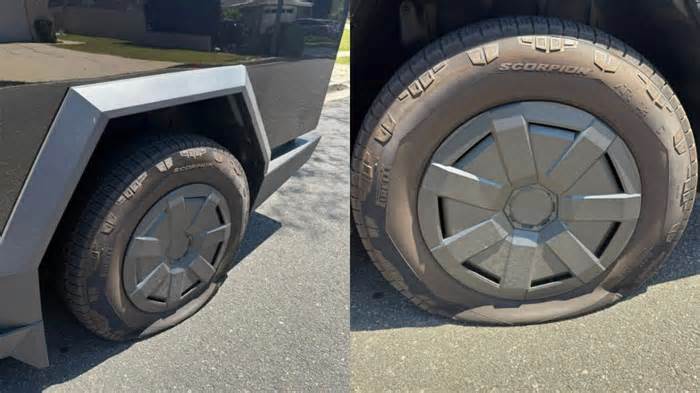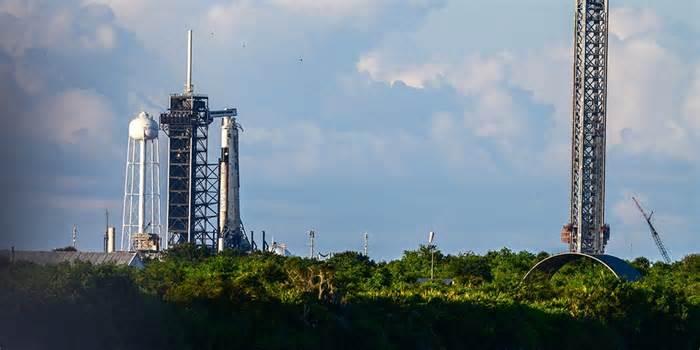
My Tesla Cybertruck Got a Flat Tire, But Don’t Make the Same Mistake I Did Because Now I’m Dealing with More Damage Than I Expected
- by Torque News
- Jun 21, 2025
- 0 Comments
- 0 Likes Flag 0 Of 5

Advertising
It’s easy to get caught up in the cutting-edge tech and rugged confidence that comes with owning a Tesla Cybertruck until something as basic as a flat tire snaps you to reality. This owner was probably thinking, "It’s just a few blocks," and suddenly that confidence turned into a costly mistake. Peter Wang, the Cybertruck owner who wrote his experience in the “Cybertruck Owners Only” group on Facebook, shared a reminder that even the toughest trucks aren’t immune to bad calls in the heat of the moment.
In Peter’s words, "If you ever get a flat tire in your Tesla, use the in-car screen to call for towing—even if you're near a tire shop. With a 6,000+ lb vehicle, even driving a short distance can destroy the tire and pop off your hubcaps (ask me how I know… forgot to take an ‘after’ photo). This might seem obvious to some, but in the moment, it's easy to act on impulse. If this post helps even one person avoid making the same mistake, then it’s worth it. Hopefully none of you get a flat—but if you do, now you know."
Why Driving Even a Short Distance Can Do Big Damage
What Peter experienced is more common than many might think. When a tire goes flat, especially on a heavy EV like the Tesla Cybertruck, the instinct to "just get to the shop" can backfire. The weight distribution of a 6,800-pound vehicle creates extreme pressure on the flat tire, causing the sidewall to collapse.
That pinch between rim and pavement not only trashes the rubber but can damage the rim and suspension components too. On top of that, if your hubcaps are mounted with minimal clearance or pressure clips, they’re likely to get ripped off during the roll as well. And while Tesla includes a towing option in the in-car interface, it’s not always the first thing on your mind in a stressful moment. But as Peter learned, it absolutely should be.
The responses to Peter’s post added even more value to the discussion, with fellow owners chiming in with both warnings and solutions that Cybertruck drivers should consider.
Todd Lamb echoed the core lesson clearly: "Great post, and in general never drive on a flat tire (run flats being the exception) you intend to get repaired as there will be damage to the tire internally where the tire gets pinched between the rim and the ground. And most shops won't pay attention to that." He brings up a crucial point that internal damage is invisible to the eye but potentially catastrophic down the road. Shops might miss it, patch it, and send you off with a tire that’s already compromised.
Paul Mayo added a technical layer to the conversation as well: "My CT tires have foam and a sensor in the middle of the tire. I just had a flat and got it patched. We found a tread sensor and had to remove a few inches of foam." While I'm not sure of the exact sensor placement, the takeaway is clear that Cybertruck tires include elements like acoustic foam that complicate repairs, and any internal damage can lead to more costly outcomes.
Brian Smith took a different approach, offering a backup plan: "Full-size spare, electric jack and impact. 15 minutes and I’m gonna keep driving." While that setup may work for more hands-on owners, not every Cybertruck driver is equipped or comfortable doing roadside tire swaps. It’s a solid reminder, though, that having a spare on hand is a smart investment if you’re venturing off-road or are far from service.
The Bigger Picture of Cybertruck Ownership
This isn’t the first time Cybertruck ownership has thrown surprises at drivers. We’ve seen drivers hauling over 2,700 pounds in the bed and another 400 in the frunk, all while reporting minimal suspension sag and impressive ride leveling. But that same sturdy design can be a double-edged sword when it comes to damage from something like a flat. The vehicle's strength means it can keep rolling when it shouldn’t, and that can give a false sense of security.
And when it comes to road risks, it isn’t always mechanical. We recently covered an incident where a Tesla Cybertruck was vandalized while the owner was inside a store. Combine that with road hazards and you start to realize that owning a Cybertruck requires a different level of readiness sometimes.
Advertising
The Cybertruck may feel like an unstoppable machine, but it’s just as vulnerable to the everyday realities of vehicle ownership as anything else. Its added weight, embedded sensors, and unique tire construction don’t make it immune, but it makes mistakes more costly. That’s why using built-in tools like Tesla’s roadside assistance isn’t just a convenience, it’s often the smarter move. We've seen how much people love their Cybertrucks despite constant attention and even daily road rage, but love alone doesn’t protect your tires—making the right judgment call does. True confidence comes from knowing when to take action and when to call in the help that’s built right into the screen in front of you.
Key Takeaways
Flat tires are not minor inconveniences: Driving even a short distance can cause cascading damage to the tire, rim, hubcap, and internal sensor components.
Use Tesla’s built-in towing option as your first response: Don’t rely on instinct or try to save time by "just rolling to the shop." That decision can cost you more in parts, time, and frustration.
Know your tire setup before a flat happens: Tesla Cybertruck tires include foam and sensors that complicate repair jobs. Ask your service center about what's inside your tire.
A full-size spare could be worth the investment: Especially if you drive in remote areas or off-road, being prepared with a jack and impact wrench could save you.
Please first to comment
Related Post
Stay Connected
Tweets by elonmuskTo get the latest tweets please make sure you are logged in on X on this browser.






 Energy
Energy


















